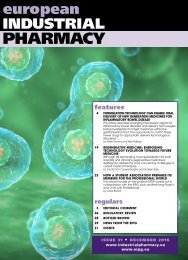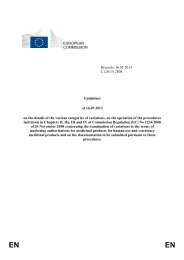PHARMACY
eip26-sep15
eip26-sep15
- No tags were found...
Create successful ePaper yourself
Turn your PDF publications into a flip-book with our unique Google optimized e-Paper software.
GETTING TO HIGHER QUALITY PROCESSES SOONER<br />
continued<br />
have tested the material in<br />
compliance with international and<br />
regional regulatory requirements.<br />
Equally, it is valuable to know if<br />
any downstream purification or<br />
inactivation measures have been<br />
taken by the supplier of the<br />
material. Beyond the mitigation of<br />
safety risks, it is also essential to<br />
know if the material in question<br />
provides the functionality that is<br />
required for its intended use.<br />
Therefore, it is important to know if<br />
the material has been used for<br />
other similar processes and/or that<br />
the supplier can provide assurances<br />
over the consistency of the quality<br />
of the material. One such method is<br />
to ask the supplier to provide a<br />
detailed specification and evidence<br />
that the material is manufactured<br />
under a recognised quality system.<br />
Equally, the developer should make<br />
sure that they carry out any<br />
characterisation, the level of which<br />
being dependent on the criticality<br />
of the material and the potential<br />
impact on final product quality if the<br />
material does not meet its<br />
specification.<br />
Applicable regulatory<br />
requirements and other sources<br />
of guidance<br />
PAS 157 contains a great deal of<br />
useful information that is intended<br />
to help developers to develop high<br />
quality processes and products. For<br />
example the difference in regulatory<br />
requirements in the EU and US<br />
relating to biological materials<br />
selection is highlighted, including,<br />
for example, the potential for using<br />
a Drug Master File in the US, but<br />
not in the EU.<br />
One major source of confusion<br />
that can occur is the differing usage<br />
of terminology in the EU and the<br />
US, and this is highlighted in PAS<br />
157, for instance, when using the<br />
terms ‘raw materials’ and ‘ancillary<br />
materials’. The intention is to make<br />
it clear to the developer where<br />
differing usage of terminology<br />
occurs, and to go some way to<br />
helping the reader deal with this<br />
situation.<br />
The document also contains more<br />
detailed information relating to the<br />
existence in the EU and US of<br />
specific regulatory requirements<br />
and guidance applicable to the<br />
manufacture of cell-based medicinal<br />
products. It highlights recurring<br />
themes that occur within each<br />
territory, and also the use of the<br />
risk-based classification system used<br />
for ancillary materials in the US.<br />
Manufacturers of biological<br />
materials available on the market<br />
can make various quality<br />
declarations about the materials in<br />
question, and it is important that<br />
the product developer is aware of<br />
what these mean, and the<br />
limitations of what useful<br />
information can be inferred from<br />
such statements. PAS 157 identifies<br />
commonly used examples of such<br />
quality declarations and explains<br />
their meanings/implications from<br />
both a technical and regulatory<br />
perspective.<br />
Evaluating supplied materials and<br />
mitigating potential risks<br />
Most developers of cell-based<br />
medicinal products will be<br />
procuring biological materials from<br />
a third party supplier. Each of these<br />
suppliers will have their own quality<br />
management regimes when<br />
demonstrating control over their<br />
processes, and there is, therefore,<br />
no single means of using supplied<br />
information to evaluate the<br />
materials and establishing potential<br />
risks associated with them. PAS 157<br />
identifies certain criteria that can be<br />
used to evaluate such supplied<br />
materials, and also steps that can<br />
be taken to mitigate risks that are<br />
identified during this process.<br />
The document also gives<br />
particular guidance on how to<br />
undertake an audit of a biological<br />
materials supplier, and also on how<br />
to use all of the information<br />
gathered to form the basis of a risk<br />
assessment.<br />
Characterisation<br />
Whilst there is shared responsibility<br />
for sufficient characterisation to<br />
demonstrate the quality of a<br />
biological material between the<br />
supplier and the developer, once<br />
the developer accepts the material,<br />
the responsibility for control and<br />
characterisation of the material lies<br />
with the developer themselves. PAS<br />
157 guides the developer on the<br />
kinds of characteristics they will<br />
need to be aware of. Commonly,<br />
this may include testing to establish<br />
the identity, purity and biological<br />
activity of the material in question,<br />
in addition to more simplistic<br />
measurements such as pH and<br />
osmolality.<br />
Changes to materials<br />
PAS 157 demonstrates that changes<br />
to the supply of biological materials<br />
gives rise to certain responsibilities<br />
to the developer to ensure their<br />
processes remain acceptable to the<br />
regulator. Changes in quality of the<br />
biological material can lead to<br />
adverse consequences on the<br />
quality of the final product, and<br />
these changes can be as a result of<br />
changes to the manufacturing<br />
process, the manufacturing site, or if<br />
the supplier stops manufacturing<br />
the product altogether.<br />
The document guides the<br />
developer in how to manage such<br />
potential changes in advance of<br />
them happening, particularly<br />
through dialogue with the supplier,<br />
and also in establishing other<br />
potential sources of the material.<br />
How was PAS 157<br />
developed?<br />
A PAS is developed to address a<br />
particular market need. This may be<br />
a request from an individual sponsor<br />
for a standardisation document that<br />
serves an emergent market,<br />
technology, service or public policy<br />
interest. The approach used in the<br />
development of a PAS is a means of<br />
quickly introducing a standardised<br />
approach. It often acts as the basis<br />
for further development towards<br />
more formal standardisation at a<br />
European or international level<br />
through international standards<br />
bodies, such as the International<br />
Standards Organization or the<br />
European Committee for<br />
Standardization.<br />
The true value of a standardisation<br />
document is that if it is often<br />
optimised, it is more widely<br />
european INDUSTRIAL <strong>PHARMACY</strong> September 2015 • Issue 26<br />
13





